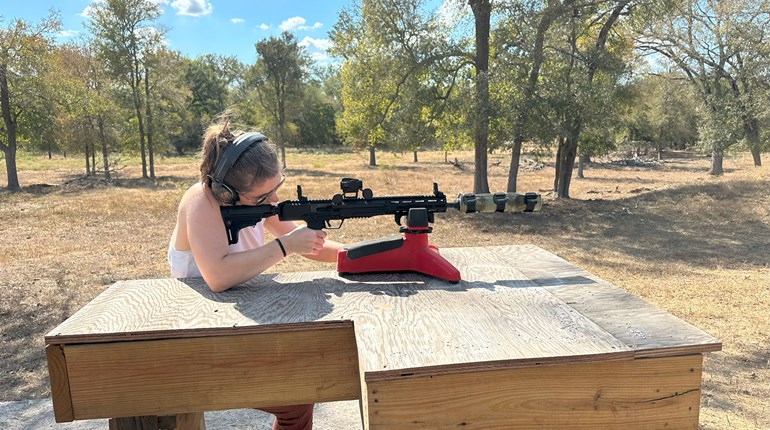
Cookouts, swimming, insect repellent and ice cream are all part of the American summertime ritual. When the Carolina heat is surpassed only by gnat-laden clouds of humidity, my mind starts to race in anticipation of one thing: hunting season. Fortunately, I treat my air-conditioned dependency with a healthy dose of gun and gear preparation. I apply some of the tricks learned while doing military reconnaissance work to my hunting guns, thereby giving me an edge in the field.
Gun Choices
Shooters are enjoying the comfort, utility and accuracy of tactical rifles on a rapidly increasing scale. Rather than allowing these utilitarian arms to lie dormant from October through January, I recommend pressing them into hunting service. Be sure to check your local and state laws for any regulations regarding semi-automatic use before doing so, though. Specific issues to look at are magazine-capacity restrictions and the attachment of lights and lasers to firearms when hunting.
The AR platform is the most popular modern semi-automatic design, available in configurations ranging from home-defense carbines to elaborate competition rigs, with many stops in between. All can be configured for effective hunting, assuming their chamberings are appropriate for the intended prey. Most states don't allow the .223 Rem./5.56 NATO cartridge to be used on large animals, but this chambering is very effective against varmints and predators. Fortunately, many options exist for additional upper receivers in larger chamberings.
Stocks and Sounds
I prefer to use a collapsible stock because of its instant adjustability. This design enables me to customize the length of pull without losing the needed eye relief in any situation that requires mobility or presents a confined space (blinds and stands). One flaw of collapsible stocks is they rattle. It may not sound like much on the range, but at first light on a calm winter morning, it is loud. Magpul offers a decent solution with its CTR stock, which has a friction device to tighten the stock to the receiver extension. It isn't perfect, but it helps. If you use a military-style, fixed AR stock, stuffing the cleaning kit compartment with something to dampen the hollow gonk sound made whenever something hits it will help, too.
Detachable-box magazines are noisy. A short magazine (five- or 10-round capacity) will reduce the side-to-side rattle in the mag well. I add a single wrap of electrical tape around the magazine at the point where it enters the well for additional sound dampening. If your magazine rattles when inserted in the firearm with the bolt forward and a round chambered, try loading one or two rounds fewer than full capacity.
Practice placing your rifle or carbine on "fire" quietly—most tactical rifle selectors are designed for safety, not stealth. So, go to your quiet place and practice in the dark (observing all firearm safety rules, of course). Don't forget about the noisy act of chambering a round. If it isn't legal, safe or practical to have a round chambered prior to reaching your hunting spot, practice chambering and checking your rifle's status quietly.
A quick-adjust sling is very helpful whenever using both hands. I adjust mine in, tight to the chest, so the barrel doesn't clang against every metal object within a half-mile radius. Long ago, I learned to place a thick, rubber retaining band on my sling so when static, it can be gathered up and held tightly against my rifle. Doing so eliminates both sling noise and sling-induced wobble when getting into position for a shot.
Sight Issues
Subdue any shiny spots where the finish has worn off your rifle. The aluminum used in tactical rifle receivers takes on a particular sheen when polished smooth by wear and tear. Trust me, these spots are easily detectable at long distance when the sun is shining. If you plan to hunt at first and last light, consider replacing your muzzle brake with a flash suppressor or a combination brake and flash hider. You'll need every bit of your remaining night vision after a shot to determine your next course of action. Think about adding a sound suppressor to your kit (if legal for hunting in your state) for the ultimate in flash suppression and hearing protection. I also set up my ARs with low-profile optical systems to reduce top-heaviness when they're laid across a rest.
Safety
Many of us prefer light match triggers for precision shooting, but you should carefully consider whether or not this will be more of a liability than an aid in the field. When you factor in cold temperatures, gloves and stress, that half-pound, single-stage trigger may seem to have a mind of its own when a 10-pointer suddenly appears.
Practice shooting with your hunting gloves on before its time to take a high-pressure shot. Military-pattern ARs allow the trigger guard to be opened for use with trigger-finger mittens. I don't recommend carrying your AR this way, but if you're hunting with heavy gloves on, you can take advantage of this feature once you're in a static position.
I only recently started hunting big game seriously. I took my first whitetail last year with a .308 Win. AR I built from the ground up as a general-purpose carbine. The techniques described above helped this handy gun rise to the task. Fortunately, we're well past the point of needing to make a case for black rifles in hunting applications. As American citizens, we're blessed with the freedom of choice. Next hunting season, I'll again choose one of my ARs when I head out to harvest some meat for the family larder.






































